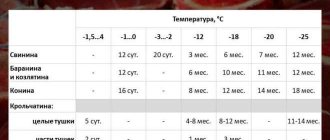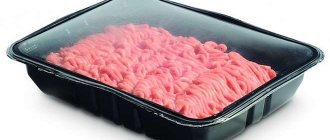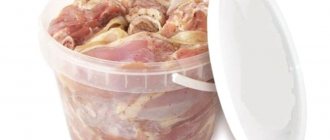Despite the fact that vegetarianism is becoming increasingly popular, meat and poultry in the diet of most people still remains the basis of nutrition. The most delicious dishes are obtained from semi-finished products that have not been frozen. They retain not only the natural taste and nutrients, but also the necessary elasticity of the fibers. However, not everyone has the opportunity to eat only fresh meat. Mostly people buy frozen foods and store them in the freezer. This is convenient, but when the need arises to quickly cook something, the problem automatically arises: how to quickly defrost meat?
There are several defrosting methods. Some of them take hours, others minutes. The last option is more convenient and profitable. However, we should not forget that if proper freezing helps preserve a high-quality product for a long time, then proper defrosting is necessary so as not to spoil the product, making it too hard and tasteless.
Today we’ll talk about how to quickly defrost meat at home while preserving its taste. We will also touch on the pros and cons of each of the most common methods.
Thawing in the refrigerator
The process of defrosting meat on the refrigerator shelf is a subject of constant debate. Most experts are of the opinion that this method is safe.
When the temperature inside the refrigerator is maintained at 4 degrees, the products do not lose their beneficial properties, and pathological processes do not develop inside them (provided the storage periods are observed). The muscle tissue remains elastic, so this type of defrosting will not cause the meat to turn into a mass without shape.
It is forbidden to defrost meat on the door, here the temperature level is higher, this will cause spoilage after 2-3 hours.
Sequence of defrosting meat in the refrigerator:
- remove the original packaging;
- place the product in a container;
- wrap the meat in cling film;
- place on the refrigerator shelf;
- leave inside for a while (each kilogram melts for about 8 hours).
Sometimes incomplete defrosting of the product is allowed, when the temperature inside it is about -4 degrees; this level allows you to cook meat without worrying about the quality of the dish.
When the product is defrosted but not yet ready to cook, wrap it in a waffle towel on top of the package. In this form it can be stored for another 3 days.
Steam defrosting
Defrosting using steam is an excellent way to achieve gentle thawing of meat, without disturbing the density of muscle tissue or destroying the structure. This method is best used for small pieces.
The process of using steam looks like this:
- place the pieces on the bottom tray of the multicooker;
- select the steam cooking mode;
- run the program;
- After the product has slightly thawed, transfer it to a higher tray.
Steam can be used in the oven:
- place the pieces in a heat-resistant container;
- place on the oven tray;
- turn on the oven at 35 degrees;
- Monitor the process and turn the meat in a timely manner.
The main disadvantage of this method is the gradual disappearance of moisture, which leads to external drying of the product, with ice remaining inside.
Freezing homemade prepared foods is the best way to save time during the week! ⇑
We seem to have figured out the defrosting methods. Now I suggest you think about how much time are you willing to spend on cooking every day? With the current pace of life, there is very little time left for cooking, and industrial semi-finished products can rarely be compared with homemade food. So what to do? There is an exit!
Tip : To spend less time in the kitchen during the work week, try to create a menu for the week on the weekend and freeze semi-finished homemade cutlets, meatballs, dumplings, dumplings, or even ready-made dishes right away.
Ever thought about this? But in vain! Homemade meals prepared for future use are a great help when you are short on time. You just need to take the container of food out of the freezer and defrost it. Both a microwave and an oven are perfect for these purposes. You and your loved ones will always be able to enjoy deliciously prepared food, and you will not have the need to use store-bought semi-finished products.
What water is best to defrost meat in?
The use of water as a source of accelerating the process of defrosting meat is allowed. The main thing is to use cold water for this purpose. Thus, the process proceeds as naturally as possible, without having a negative impact on the product.
The use of hot water is allowed occasionally, with a short time interval. When using this method, active proliferation of pathogenic microflora inside the piece occurs.
In cold water
The defrosting process looks like this:
- place the meat product inside a plastic bag;
- pour cold water into a bowl;
- place the bag inside the container, make sure that no water or air gets inside it;
- periodically change the water in the bowl with new water, every half hour.
In hot water
The use of hot water is allowed in emergency cases when the product needs to be separated from the bag (if it has frozen too tightly to it), or to separate whole pieces that have been frozen into a monolith.
Carry out the defrosting process in the same way as with cold water. Just keep the raw materials for the minimum possible time inside a container filled with hot water. If this rule is not followed, microbes will begin to actively multiply inside the product.
In the microwave
A microwave is the most convenient device for defrosting meat products. The main thing is to follow the rules to prevent the appearance of an unpleasant odor and the loss of juiciness in the meat.
The correct process for using a microwave oven:
- Remove packaging from meat.
- Place the product inside a special container and cover it with a lid.
- Turn on the desired mode.
- After 3 minutes, stop the device and turn the meat over.
- Repeat the steps until you achieve your goal (usually takes up to 30 minutes).
If the model is not equipped with a defrosting function, set the power to high, also periodically stop the device and turn the meat over, checking the degree of defrosting.
The advantage of using a microwave oven is the absence of changes in the taste of the finished dish, its structure, and the complete safety of the product for health.
Tips for using a microwave oven
Sometimes, in the hustle and bustle of the day, the operating standards of the device fade into the background. Well, admit it, who hasn’t done this, for example, stuffed a sandwich on a plate with a gold border, or a hamburger in plastic into the inside of the oven. Such rash steps can not only ruin the unit, but also negatively affect the quality of food. To extend the life of kitchen appliances, and to avoid poisoning yourself, you should listen to the following tips:
- When cooking in a microwave oven, meat and other products must be in a special container;
- Products in vacuum packaging should be pierced in several places before processing;
- It is advisable to place food in the microwave in small parts so that defrosting occurs evenly;
- Use utensils that are designed exclusively for the microwave oven, and do not have gold-colored designs or are made of metal;
- It is necessary to observe the safe operation of the device;
In the oven or slow cooker
It is advisable to use an oven if it is electric. A gas oven is characterized by sudden changes in temperature, which is why ice remains inside the meat and a crispy crust forms on the outside.
Defrosting in an electric oven:
- place on the grill, after placing the piece inside a suitable container;
- preheat the oven to 35 degrees;
- periodically unwrap the product in different directions.
If the oven is equipped with a convection function, turn on the mode and place the food in containers on the middle part of the baking sheet. The air movement created by the fan will help defrost the piece.
The multicooker also copes well with the process of defrosting meat. Place the container on the bottom shelf of the device, select the steam cooking mode. After a while, move the bowl to a higher shelf.
Despite the speed of defrosting when using these methods, experts do not recommend their use because they significantly change the taste of the finished dish.
How to Thaw Meat Using Apple Cider Vinegar
Apple cider vinegar can speed up the defrosting process. It is used this way:
- put the product inside a plastic bag;
- immerse in deep container;
- pour a mixture of water and apple cider vinegar inside in a 1:1 ratio;
- after a reaction occurs between ice and vinegar, the thawing process will begin, because a greenhouse effect occurs inside the bag.
The advantage of this method is the complete preservation of the properties and taste of meat after defrosting.
Useful tips
There are a number of recommendations, following which the housewife can defrost the product without losing its taste:
- experts believe that this process should be as long as possible, unlike freezing. Only then will the dish turn out tasty;
- if the housewife plans to bake or boil the meat in one piece, then it can be cooked immediately, without waiting for it to thaw;
- if the defrosted product could not be cooked immediately, it is better to marinate it and cook it later;
- after defrosting, the meat must be rinsed with running water and dried with a paper towel;
- Poultry has a more delicate texture than beef and pork. Therefore, the ideal way to defrost it is to place it in the refrigerator;
- it is imperative to remove excess liquid that is formed as a result of thawing, because harmful microorganisms form in it;
- It is recommended to store any defrosted meat products for no more than 8 hours.
By following all of the above recommendations, the housewife will be able to defrost meat without losing its nutritional properties. Also, as a result of cooking, it will remain juicy.
Many housewives are interested in the question of how to speed up the defrosting process, despite the advice of experts to make this process as slow as possible. You need to wait for the meat to thaw slightly, and then cut it into medium-sized pieces. Or put the container with the product in a warm place - this will also speed up the process.
But you should not expose it to high temperatures for a long time. There is a high chance that the meat will not cook properly. Therefore, heating should be short-term and with constant monitoring of the state of readiness of the meat.
How not to defrost meat
Defrost meat strictly according to established rules, otherwise it will not only lose its taste and external qualities, but may also become hazardous to health.
What not to do:
- Place meat products on central heating radiators.
- Use hot water or an oven to keep frozen meat for a long time.
- Try to defrost the meat as quickly as possible.
- Subject an already thawed product to re-freezing.
- Freezing meat in large pieces will make it difficult to defrost it further and will force unneeded parts to be re-frozen.
- Store for a long time at temperatures above 0 degrees.
General Tips
General tips will be useful to every cook. So, keep the following in mind:
- You should not use an oven (oven) to defrost meat, as this promotes the growth of pathogenic microflora. Such meat will be harmful to eat. For the same reasons, to speed up the defrosting process, it is not advisable to place the product on the battery.
- If you need to defrost frozen boiled or smoked meat at home, you can use any of the methods described above. Each one is suitable.
- Remember that freezing meat should be as fast as possible, and defrosting as slow as possible. This way it is possible to preserve the protein structure and nutritional properties of the product.
- It is not advisable to re-freeze defrosted meat. This leads to the final destruction of protein molecules, which guarantees destructive changes in the structure of the meat. Research by scientists has shown that in a once frozen meat product, the protein content is reduced by half, and when re-frozen, it tends to zero. In other words, a repeatedly frozen product is a collection of useless fibers.
- It is not advisable to freeze meat in large pieces, since subsequent defrosting will be quite problematic and time-consuming.
- Remember that frozen meat can be stored for up to twenty-four months if the temperature is kept below freezing at all times.
In principle, there is nothing complicated in defrosting meat for any purpose (cooking in a frying pan or grill, cooking soup or broth, creating barbecue, preparing jellied meat or pancakes with meat, etc.). Remember that the most gentle and safe way is to defrost food in the refrigerator. After this, the food can be stored for up to five days. When choosing other defrosting methods (using cold/hot water, microwave, multicooker, double boiler), the product must be cooked immediately.
Features of defrosting different types of meat
Each type of meat has its own characteristics, therefore the process of defrosting them should take into account these subtleties. This will preserve the taste of the final dish, prevent changes in the structure of the fibers, and prevent the meat from losing its aesthetic appearance.
How to quickly defrost chicken meat
Chicken dishes are prepared only from previously defrosted raw materials. Active defrosting can cause a significant deterioration in the appearance of the chicken.
Instructions for defrosting chicken:
- Peel the carcass from the wrapping paper, place it inside a deep container, and cover with a lid.
- Place it on the refrigerator shelf.
- The average defrosting speed for a small chicken is no more than a day.
If you need to get the product a little earlier, use cold water. As a rule, the carcass becomes suitable for further cooking in about an hour.
How to quickly defrost beef
Proper thawing is very important for beef, it will help keep the steaks looking great and tasting great. Never use hot water for this procedure, and do not leave meat on the table in the room. An oven will not work here either; already at 35 degrees the process of protein denaturation will begin. Because of this, the meat will begin to cook before it defrosts. In this case, active proliferation of bacteria begins, which will jeopardize the safety of the finished dish.
It is better to defrost beef on the bottom shelf of the refrigerator. Pre-wrap the meat in plastic to prevent it from coming into contact with air and foreign odors. Medium-sized steaks (about 2.5 cm) will defrost in about 12 hours.
Thawed beef can be stored for no longer than three days in a refrigerator.
Quickly defrost beef:
- put the meat in a bag;
- Immerse the bag in ice water, previously poured into a deep bowl;
- change the water to cold every 30 minutes, within 2 hours the defrosting process will be completed;
- After defrosting is complete, remove the meat from the packaging and let it breathe for a few minutes, only then begin the cooking process.
How to quickly defrost pork meat
Pork can be used using a variety of methods:
- cold water;
- apple cider vinegar;
- refrigerator.
The use of salt has a good effect, increasing heat transfer, due to which the meat defrosts faster.
Salt defrosting method:
- dilute salt and water in a deep container in the proportion of half a glass per liter;
- remove the packaging from the meat;
- put the meat in salted water.
How to properly defrost turkey meat
Turkey meat is distinguished by its delicate texture, so handle it as carefully as possible and under no circumstances subject it to rapid defrosting.
Turkey defrosting technology:
- put the carcass in a bowl and put it in the refrigerator;
- after 7 hours, remove the carcass;
- pour cold water into the container;
- put the carcass in a bag, lower it into water;
- Change the water every half hour; the defrosting process will take up to three hours.
You cannot store turkey at temperatures above 15 degrees, as pathogenic microflora will actively multiply inside and spoilage processes will begin.
Proper freezing
In order for a dish of chilled meat to be a success, it is important to initially freeze it correctly. Our website has detailed articles on how to properly select and store meat products.
Of course, it is best to use products while they are fresh, but if this is not possible, then low-temperature treatment comes to the aid of housewives.
Here are some guidelines for properly low-temperature processing of meat products.
If you are refrigerating a large piece, it is better to cut it into smaller pieces, if this allows the dish that you plan to cook later. Then the meat should be placed in separate plastic bags and placed in the freezer.
Note to the housewife: on each package of meat you should write the processing date, so it will be more convenient for you to determine which piece is best to cook first.
If you want to store minced meat in the freezer, then you should also divide it into portions, giving them a flat shape. This way the minced meat will thaw faster and take up less space in the freezer.
Attention: in the freezer, fruits and vegetables are stored separately from meat!
How to quickly defrost meat outdoors
Defrosting meat products in the fresh air is not the safest method. Firstly, at temperatures above 15 degrees, bacteria will begin to multiply inside. Secondly, insects that carry dangerous diseases can land on the product.
When you need to defrost meat outdoors, you need to take care of this in advance. While still at home, you should remove the meat from the freezer and place it on the refrigerator shelf. Afterwards, when the meat has thawed by about half, it is placed in a bag. Meat is transported outdoors in a thermal bag, which prevents it from spoiling under the influence of heat.
How many times can you defrost meat?
Re-freezing already thawed meat is allowed only if it has been defrosted on the refrigerator shelf and has not thawed completely. There is no particular danger here; the only drawback of such manipulations will be the loss of juiciness and part of the taste of the meat.
A product that has melted in the oven, microwave, cold or hot water should not be re-frozen. During such processes, active reproduction of the pathogenic microflora inside occurs. During repeated defrosting, these processes will begin much earlier, in addition, part of the protein will be destroyed, which will make the finished dish tough, not so nutritious and tasty.











